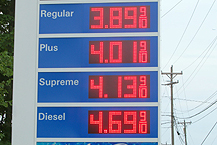Vice Versa
Americans Shocked by Fuel Prices into New Lifestyles

A visitor returning to the United States after a one-year absence would not notice much difference in how Americans live. But changes abound, if one looks at statistics.
In the first five months of 2008, drivers traveled 2.4 percent fewer miles than in the same period of 2007, according to the U.S. Transportation Department. Trips on subways, buses and light rail reached a 50-year high in 2007. Bicycle riding has skyrocketed. Sales of gas-guzzling sport utility vehicles have plummeted.
Americans are changing their ways in response to high fuel prices, according to economists.
A June poll conducted for the Washington Post indicates that, for the first time, the majority of Americans believe rising gas prices are causing financial hardship.
Experts say consumers’ response likely signals a long overdue cultural shift that may put the United States on a more “sustainable” path in terms of its energy use.
U.S. Transportation Secretary Mary Peters said she believes Americans have already passed the tipping point.
WHAT WENT WRONG?
The oil crises of the 1970s taught Americans to use fuels judiciously, experts say. But as petroleum prices stabilized around $20 per barrel in the 1990s, American consumers abandoned prudence and bought ever more powerful, gas-guzzling vehicles and ever bigger houses.
As city residents continued a decades-long move outward, settling in suburbs and exurbs (areas beyond suburbs), their commutes lengthened. Average U.S. daily petroleum consumption, of which transportation represents more than two-thirds, increased by almost 20 percent from 1995 to 2005, according to the Energy Information Administration.
“Now, as the cheap energy is going, going, almost gone, we are experiencing a paradigm shift,” Steve Andrews, an energy expert based in Denver, told America.gov.
The change will not be fast or easy, he and others caution.
WHERE DO WE GO FROM HERE?
Transitioning to the next generation of hybrid and electric vehicles, which can help reduce America’s oil dependence, will take time and a lot of money. Major automakers, which for a long time did not see the need for vehicles burning less or no oil, began pursuing innovative technologies seriously only when Congress enacted tougher fuel economy standards in 2007.
Transforming the pattern of U.S. urban development will take longer. One illustration of the status-quo mindset comes from the state of Maryland, which recently decided to invest billions of dollars in a highway project rather than improve its public transportation.
Some other states, counties and cities were introducing standards for higher-density, transit-oriented development and encouraging biking, telecommuting, carpooling and the use of public transportation to address suburban sprawl, traffic congestion and fuel use even before the current crisis.
But Douglas Farr, a Chicago architect who published the book Sustainable Urbanism, says these solutions will not amount to much if they are separate from each other, even if adopted on a broad scale. He calls for a plan that integrates such solutions in compact, walkable and transit-served settlements with energy- and water-efficient buildings.
Farr told America.gov that the first major test of America’s willingness to tackle the issue will come in 2009, when the next Congress considers a transportation bill, which sets priorities and funding for highways and public transportation.
WILL GOVERNMENT ENTER THE FRAY?
Consumer demand and demographic changes, which support retreat from suburbia, will drive the transformation more than Congress, experts say. Graying baby boomers gravitate toward city centers, and their out-of-college kids are drawn by downtown nightlife.
Developers will refocus on cities if they have profits to make, according to Farr. And there is potential for good profits.
“Sustainable urbanism is the biggest economic opportunity we have ever seen,” he said.
But Farr believes the government must get more involved.
Many experts share this view. Andrews said more drilling for oil in the United States should be made contingent on measures designed to dampen demand, such as reducing and strictly enforcing speed limits and introducing incentives for consumers to buy fuel-efficient or electric cars.
Michelle Foss, an energy economist at the University of Texas at Austin, rejects the notion that government intervention is necessary and says it is often counterproductive. She told America.gov she believes the market itself will force necessary changes, as evidenced by recent consumer behavior.
Farr said, however, that car-based suburban development has not been a product of unrestrained market forces but rather of the system of direct and indirect subsidies “rigged for us to drive more.” This system must be dismantled, he said.
David Garman, an energy consultant who served in the Bush administration as under secretary of energy, believes the federal government should do more. For example, he told America.gov, numerous studies indicate that it makes much more economic sense to fund technology research and development early than try to impose solutions later.
Recently on Vice Versa
Will increasing energy prices change the American way of life?
 Dany Claeys is correspondent in Charlotte, NC for myAmerica.be. About 25 years ago he moved to the United States. Says Dany: "During all my years in the USA, I always managed Belgian owned companies (Barco and Agfa) and acted as a bridge between Belgian and American cultures."
Dany Claeys is correspondent in Charlotte, NC for myAmerica.be. About 25 years ago he moved to the United States. Says Dany: "During all my years in the USA, I always managed Belgian owned companies (Barco and Agfa) and acted as a bridge between Belgian and American cultures."
Naar de tandarts ... A Visit to the Dentist...
 Ken Coppieters is a Belgian scientist working at The La Jolla Institute for Allergy and Immunology and lives with his wife Helena in San Diego, California. He is a regular contributor to this web site.
Ken Coppieters is a Belgian scientist working at The La Jolla Institute for Allergy and Immunology and lives with his wife Helena in San Diego, California. He is a regular contributor to this web site.
In this article he writes about the issue of medical/dental insurance and cost in the United States.
We feel at home in Charlotte, North Carolina...
 Dany Claeys is correspondent in Charlotte, NC for myAmerica.be. About 25 years ago he moved to the United States. Says Dany: "During all my years in the USA, I always managed Belgian owned companies (Barco and Agfa) and acted as a bridge between Belgian and American cultures."
Dany Claeys is correspondent in Charlotte, NC for myAmerica.be. About 25 years ago he moved to the United States. Says Dany: "During all my years in the USA, I always managed Belgian owned companies (Barco and Agfa) and acted as a bridge between Belgian and American cultures."
English (via Google)